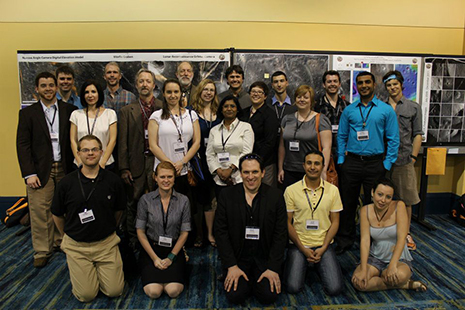Space Center Reacts to Mars Rover Landing
Late Sunday night, members from the Arkansas Center for Space and Planetary Sciences gathered in the Old Field House and anxiously awaited the landing of the Mars Science Laboratory, Curiosity. The car-sized rover was scheduled settle down in a landing ellipse in the northwest corner of Gale Crater on Mars. For the graduate students and researchers at the Space Center, Curiosity is another tool to provide data and information that will enable them to help solve the mysteries of the planet.
The landing sequence, known as the “7 minutes of terror,” was the most complex ever attempted. Beginning at the top of the Martian atmosphere, an atmosphere that is 100 times thinner than Earth’s, the spacecraft carrying the rover was travelling at 13,000 miles an hour. The spacecraft’s heat shield protected the rover from the friction of the atmosphere as thrusters steered the spacecraft to the proper heading. While the rover was still traveling at 1,000 miles an hour, nearly two times the speed of sound, its parachutes deployed, slowing the spacecraft even further. Once the craft slowed to 200 miles an hour, rockets fired, bringing it almost to a stop before the sky crane on the spacecraft lowered Curiosity to the Martian surface.
At 12:32 a.m. CDT, mission control commentator Allen Chen gave the final word. “Touchdown confirmed. We’re safe on Mars!” Cheers and applause erupted in the control room at the Jet Propulsion Lab in Pasadena, Calif., and in the small meeting room of the Arkansas Center for Space and Planetary Sciences.
“It’s incredible when you think about it! There were so many steps to the landing sequence, and if any one thing went wrong, it would have meant disaster for the entire mission,” said Will Bryan, a graduate student studying Martian clays. “This is going to completely change the way we explore space.”
Just minutes after the signal reached Earth confirming a successful touchdown, scientists received the first images. The black and white pictures from the rover’s hazard avoidance cameras showed the left-rear wheel on the ground and the rover’s shadow.
With the landing successful, the team at the Jet Propulsion Lab now begins the primary mission phase, scheduled to last two years. During this time, the roving chemical lab will take photographs, use its suite of instruments to investigate the rocks and soil and send unprecedented amounts of data back to Earth, where scientists, including those at the University of Arkansas, will use the information to decode the planet’s past.
The Space Center graduate research program has several teams that look at Mars, all with different focuses.
Vincent Chevrier’s team looks at the history of water activity and how it affected the chemistry and mineralogy of the surface. They have achieved success working with the NASA Phoenix lander data.
Tim Kral and Dan Lessner of the Space Center and biological sciences department have grants from NASA and the National Science Foundation to study microorganisms called methanogens and how they survive and adapt under Martian conditions. Their work, completed with graduate and undergraduate students, could answer questions about life on the Red Planet.
John Dixon, a geosciences professor and the associate director of the Space Center, and his students study the surface morphology of Mars and use Earth analogs to help determine formation and evolution processes and to address questions of life on Mars.
Curiosity’s instruments, ‘Sample Analysis at Mars,’ will ‘follow the carbon’ and will add valuable data to my research. I could not be more excited about the possibility of the discovery of past or present life on Mars!” Navita Sinha, a graduate student focusing on astrobiology, said.
“The Space Center here at the U of A has unique research facilities for creating and simulating Martian conditions in the laboratory, a capability that is essential for understanding the explosion of new data that will be obtained robotically by the [Mars Space Laboratory],” said Lin Oliver, director of the Space Center. “Our faculty, current and future students are filled with curiosity about the habitability of Mars, and NASA has now provided us with an incredible new vehicle for satisfying this curiosity. We could not be more excited!”
Contacts
William T Bryan, Graduate Student
Arkansas Center for Space and Planetary Sciences
256-714-7643,
wxb004@uark.edu
Headlines
Four Students Named Goldwater Scholars; Two Earn Udall Honorable Mentions
Four U of A students have received the prestigious Goldwater Scholarship, an award for top students in mathematics, science, and engineering.
Cross-Campus Collaboration Culminates in New Outdoor Geological Installation
Grand opening event to celebrate the new GeoLab installation at the U of A’s Gearhart Hall courtyard is set for May 3. The installation will be open to the public year-round.
First Students to Use Online Degree to Hone Nursing Leadership, Elevate Patient Care
Hanna Baxendale and Wendi Kimbrell will begin coursework in the Doctor of Nursing Practice-Executive Master of Business Administration program offered by the Eleanor Mann School of Nursing and Walton College.
Join the Office for Sustainability on a Final Cruise to Campus
Cruise to Campus Wednesdays have fostered a gathering space for individuals interested in biking to campus. Drop by the Old Main Lawn from 7:30-10 a.m. Wednesday for coffee, something to eat and conversation.
Fay Jones School Student Ambassador Program Gives Voice to Design Students
The student ambassador program at the Fay Jones School of Architecture and Design is built to connect top design students with their school, its alumni, its future students and others inside and outside the school.





